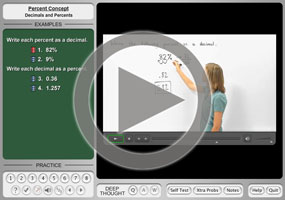Converting Between Decimals, Fractions, and Percents
Percent to FractionDecimal to FractionDecimal to PercentFraction to DecimalFraction to PercentEquivalents
Purplemath
Percentages refer to fractions of a whole; that is, whatever you're looking at, the percentage is how much of the whole thing you have. For instance, "50%" means ""; "25%" means ""; "40%" means ""; et cetera.
Often you will need to figure out what percentage of something another thing is.
Content Continues Below
For instance, if a class has 26 students, and 14 are female, what percentage of the students are female? It is 14 out of 26, or = 0.538461538462..., which is about 54%. (For more information on "percent" word problems, look at the Percent of lesson.)
"Percent" is actually "per cent", meaning "out of a hundred". (It comes from the Latin per centum for "thoroughly hundred".) You can use this "out of a hundred" meaning, along with the fact that fractions are division, to convert between fractions, percents, and decimals.
How do you convert from percents to decimals?
Affiliate
Advertisement
Percent-to-decimal conversions are easy; you mostly just move the decimal point two places. The way I keep it straight is to remember that 50%, or one-half, of a dollar is $0.50. In other words, I have to move the decimal point two places to the left when I convert from a percent (50%) to a decimal (0.50).
To do any other percent-to-decimal conversion, I move the decimal point the same number of places in the same direction, and drop the "%" character.
Here are some more examples of this conversion process:
27% = 0.27
I dropped the "%" character and moved the decimal point two places to the left.
104% = 1.04
This percentage had three digits, so moving the decimal point two places to the left still left a digit on the other side of the decimal point. You should expect this result from time to time.
0.5% = 0.005
This percentage already had a decimal place, which meant that the decimal form would have three. Don't assume that your decimal forms will always have two decimal places; they can have many, or even none. It'll depend on the percentage.
You can use the Mathway widget below to practice converting a percentage to a decimal. Try the entered exercise, or type in your own exercise. Then click the button to compare your answer to Mathway's. (Or skip the widget and continue with the lesson.)
Please accept "preferences" cookies in order to enable this widget.
(Click here to be taken directly to the Mathway site, if you'd like to check out their software or get further info.)
How do you convert percents to fractions?
To convert a percent to a fraction requires the use of the fact that "percent" means "out of a hundred". First you move the decimal point two places to the left (to convert the percent to a decimal), and then you convert the decimal to an out-of-a-hundred fraction. Then you simplify that fraction, if possible. For instance:
First I dropped the "%" character and moved the decimal point two places to the left. Then I converted the decimal to an out-of-a-hundred fraction. Now I can reduce the fraction:
Affiliate
Most of these conversions are simple like the one above, but some require a little extra care. The reason I converted to a decimal first is that the number of decimal places tells me how many zeroes to have underneath. Notice that "0.40" can also be written as "0.4". Then 0.4 = , which is the same answer as before. It works out because "0.4" has one decimal place and "10" has one zero. This concept (matching the number of decimal places with the number of zeroes) helps in more complicated problems:
Here are some more examples:
Note that this percentage had a decimal place. This is what required the decimal to have three decimal places. Don't just assume that all percentages will convert to two decimal places. Pay attention to what you're doing!
Note here that the fraction is carried right along. Yes, the decimal point is moved two places to the left, but the fraction doesn't budge. Then the resulting mixed number is placed over a hundred: two zeroes for the two decimal places in the decimal form. The fraction does not count toward the decimal places in your fractional form.
Because ½ is a terminating decimal (namely, 0.5), this percentage is simpler to convert than was the previous one. Since the decimal form had three decimal places, the conversion fraction had three zeroes in the denominator.
If you plan to take a business-math class, you should expect to need to work with percentages which contain fractions. It's a good idea to understand how to do this stuff anyway, but I've only ever seen it come up in business classes.
If you have a graphing calculator, you can probably have the calculator do this conversion for you. Check your manual.
You can use the Mathway widget below to practice converting a percentage to a fraction. Try the entered exercise, or type in your own exercise. Then click the button to compare your answer to Mathway's. (Or skip the widget and continue with the lesson.)
Please accept "preferences" cookies in order to enable this widget.
(Click here to be taken directly to the Mathway site, if you'd like to check out their software or get further info.)
URL: https://www.purplemath.com/modules/percents.htm
Select a Course Below
Standardized Test Prep
Homeschool Math
© 2024 Purplemath, Inc. All right reserved. Web Design by ![]()




